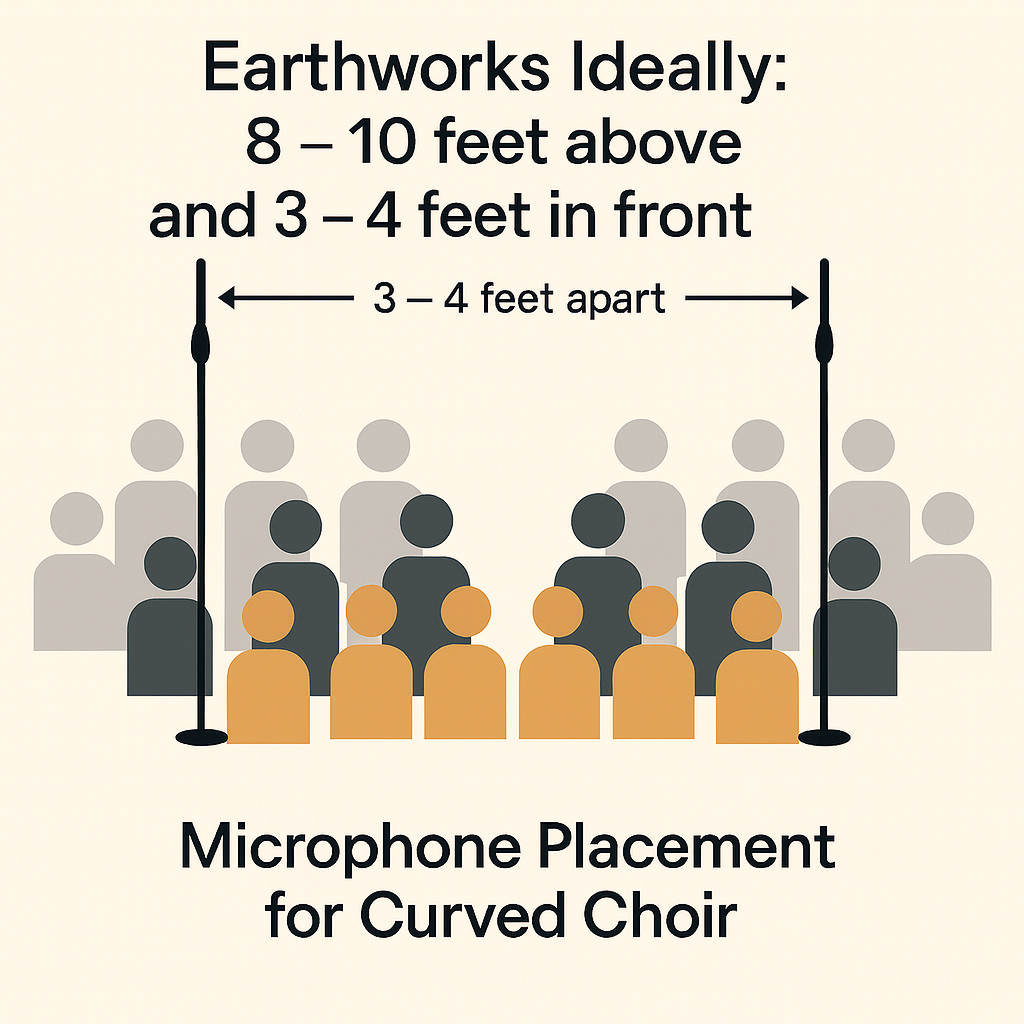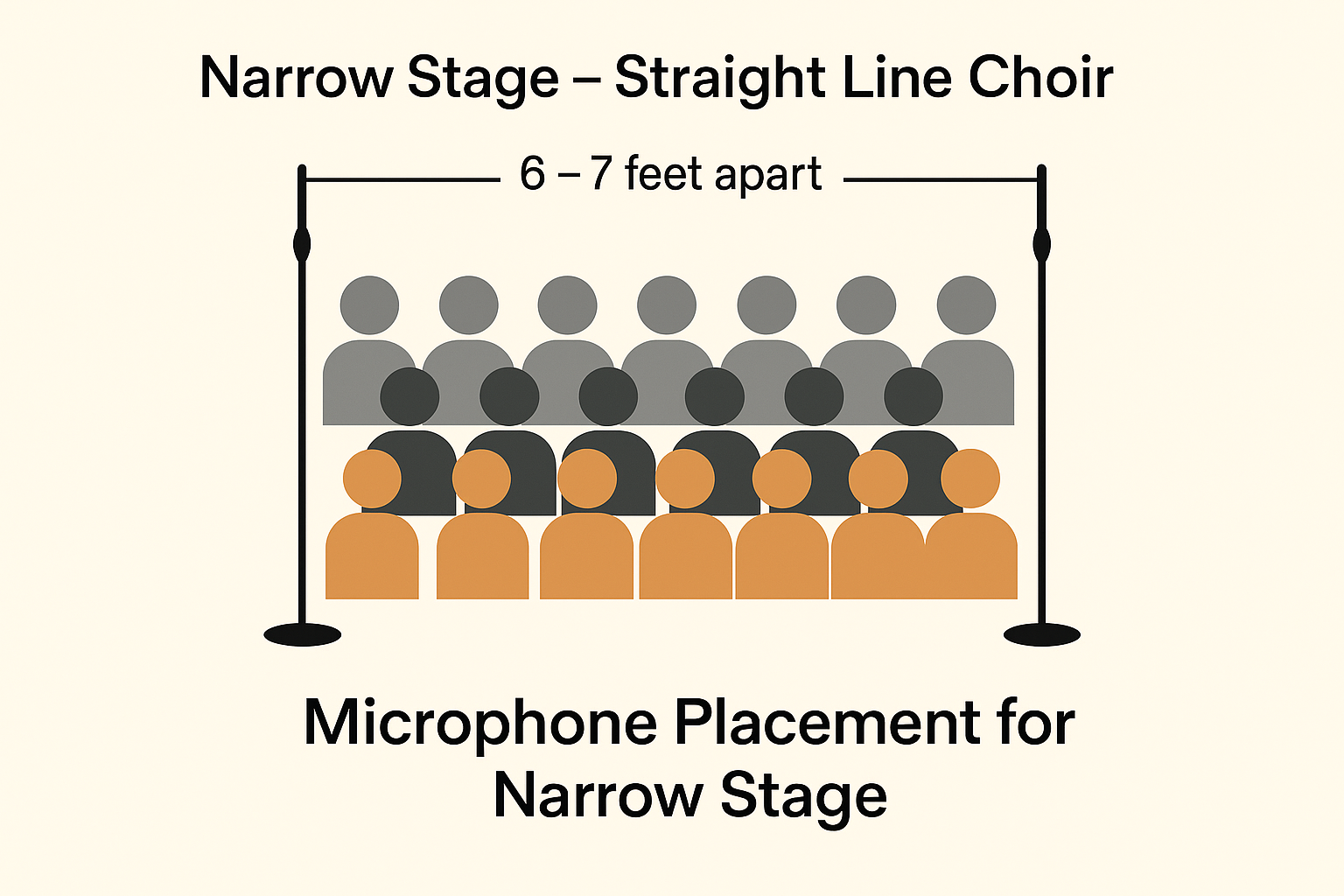Why Earthworks Gen 2 Mics Are the Gold Standard for Live Choir Reinforcement
🏛 Introduction
Reinforcing a choir live is one of the most challenging tasks in audio. Choirs spread wide across a stage, voices are often soft, room acoustics can be unpredictable, and the PA is usually much closer to the choir than ideal.
At Humecky Audio & Video, we use Earthworks Gen 2 choir microphones because of their natural clarity, incredible gain-before-feedback, and the ability to capture a choir the way it truly sounds — powerful, unified, and expressive.
But even the best microphone needs proper placement. This guide breaks down microphone height, distance, spacing, stage-type variations, EQ, and effects, along with visual diagrams for multiple real-world setups.
🎶 Why Mic a Choir at All?
1. Makes the Choir Sound Bigger
Microphones allow you to lift the overall choir volume so the audience hears a full, rich ensemble, not just the front row or the loudest singers.
2. Enhances Blend and Perceived Tuning With Effects
Properly used effects can improve overall cohesion:
- Chorus FX (used very lightly) adds width and can smooth minor pitch differences.
- Reverb adds depth, warmth, and a “concert hall” feel so the choir sounds more polished.
- A subtle tap delay can soften sharp consonants and improve perceived timing.
3. Allows Section Balancing
With multiple mics, the audio engineer can:
- Boost harmony groups when needed.
- Bring out the men’s parts during key sections.
- Add presence to sopranos when they carry the melody.
- Support weaker sections without overpowering the rest of the choir.
4. Improves Clarity in Any Room
Microphones help overcome poor acoustics, large sanctuary spaces, mixed seating, and general crowd noise. A properly mic’d choir always sounds more controlled and professional.
🎼 Why We Use Earthworks Gen 2 Choir Microphones
- Natural, transparent tone – what the choir sings is what the audience hears.
- High sensitivity, low noise – captures the ensemble without spotlighting individual “hot” voices.
- Excellent gain-before-feedback – crucial in churches where speakers are close.
- Wide coverage – each mic can realistically cover around 50 singers, so multi-mic setups are efficient and powerful.
📍 Ideal Microphone Placement (With Diagrams)
Below are several common stage layouts, with diagrams that show recommended heights, distances, and spacing for Earthworks Gen 2 choir mics.
1️⃣ Flat-Floor Choir (No Risers)

When the choir stands on a flat floor, the mics must be higher and clearly in front to “see” the back rows.
- Height: 8–10 ft above tallest singer
- Distance in front: 3–4 ft
- Spacing between mics: about 6–8 ft
- Why: Prevents picking up individual singers and improves overall blend and clarity.
This setup is common in gyms, fellowship halls, and multipurpose spaces where risers aren’t available.
2️⃣ Curved Choir on Risers (Standard Setup)

This is the most typical layout for church choirs: three or more rows on risers in a gentle arc.
- Height: 8–10 ft above the tallest singer
- Distance in front: 3–4 ft
- Spacing: around 3–4 ft between microphones for a moderate-width arc
- Why: Risers let the microphone “see” each row, giving even pickup from front to back.
3️⃣ Large Curved Choir (3-Mic Setup)
For wide-area choirs of around 80–150 singers, a three-mic configuration offers both coverage and control.
- Height: 8–10 ft above tallest singer
- Distance in front: 3–4 ft
- Spacing: about 5–6 ft between mics along the curve
- Why: Covers a wide arc while allowing the engineer to balance left, center, and right sections.
With multiple mics, the audio engineer can subtly ride different sections, boosting harmonies, men’s parts, or melody lines without changing the whole mix.
4️⃣ Narrow Stage — Straight Line Choir

When the stage is narrow and the choir must stand almost in a straight line, the spacing strategy changes slightly.
- Height: 8–10 ft
- Distance in front: 3–4 ft
- Spacing: 6–7 ft apart to cover the line of singers
- Why: Wider spacing helps cover the line without creating hot spots at the ends.
🎤 How Many Mics Should You Use?
- 1–2 mics: Small choirs or very narrow stages.
- 2–3 mics: Medium to large curved choirs.
- 3–4 mics: Extra-wide stages or very large choirs where sections are spread out.
Using at least two microphones dramatically improves stereo image, blend, and section control, while still keeping the setup simple and clean.
🎚 EQ Settings for a More Pleasant Choir Sound
These are starting points; always adjust to the room and choir.
- High-Pass Filter (HPF): 120–150 Hz normally, up to 180–200 Hz in very boomy rooms.
- Low-Mid Cleanup: Gentle cut of 2–4 dB around 200–300 Hz to reduce muddiness.
- Presence Boost: Light boost around 3–4 kHz for articulation and lyric clarity.
- Air Band: Subtle lift around 10–12 kHz to add openness and sparkle.
Smart EQ choices are a huge part of making the choir sound pleasant, open, and professional.
🎛 Using Effects to Enhance Choir Blend
Reverb
Reverb is the most important effect for choir:
- Hall reverb – lush, warm, and wide.
- Plate reverb – brighter and more defined, great for modern worship.
- Room reverb – subtle and natural, good for already-live spaces.
Suggested settings:
- Pre-delay: 20–35 ms
- Decay: 1.8–2.5 seconds
- High-cut: 8–10 kHz to keep things warm
- Wet mix: 15–25% depending on room size and style
Chorus FX
A very subtle chorus can:
- Smooth slight pitch differences between singers.
- Add stereo width and a gentle “sheen.”
- Help the choir sound more unified without sounding artificial.
Compression & Dynamics
Use light compression just to control peaks, not to squash dynamics:
- Ratio: around 2:1
- Attack: 20–30 ms
- Release: 150–250 ms
If you use an expander, keep it very gentle. Hard gates tend to sound choppy and unnatural on choirs.
🎬 Final Thoughts
Miking a choir is not just about making it louder — it’s about making it sound bigger, fuller, and more musical. With the right microphones, correct placement for your stage type, thoughtful EQ, and tasteful use of reverb and chorus FX, any choir can sound more blended, more in tune, and more inspiring.
Whether your choir is on risers, a narrow stage, a wide curved arc, or standing on a flat floor, these guidelines and diagrams will help you get the most out of Earthworks Gen 2 choir microphones in live worship environments.
____________________________________________
Links to Products
